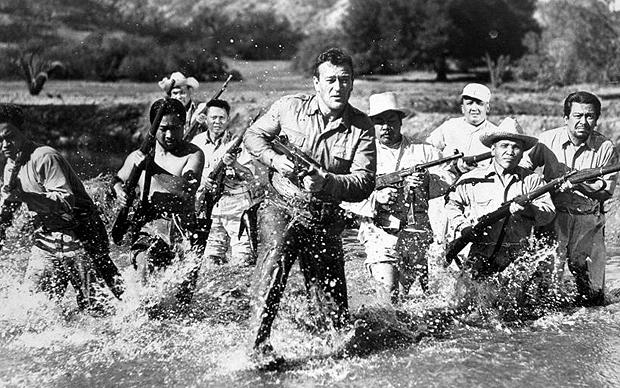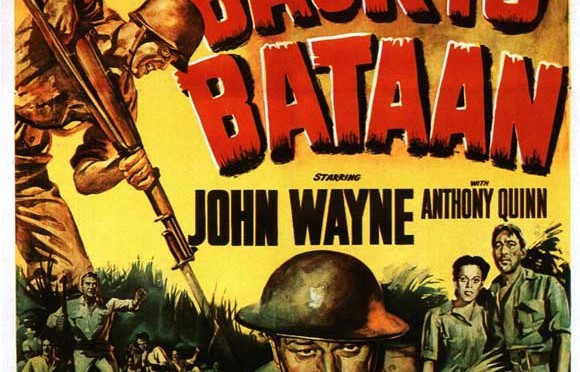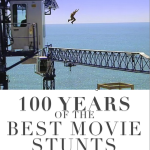When John Wayne first started acting in films, he didn’t do a lot of his own stunts. As the years passed and he gained experience, he became friends with a lot of the stunt performers of the early days of film like Yakima Canutt and he started taking on a lot more of the stunts himself. In Back to Bataan (1945), he decided to do ALL the stunts himself.
In the book, John Wayne: American, it states that during the filming, Edward Dmytryk, the director and Ben Barzman, the screenwriter, found out that Wayne refused to use a stunt double and together, they collaborated in writing scenes that they thought would make Wayne insist on a stunt double to do the painful scenes. In one scene, Wayne was required to be lifted in the air by leather harness to simulate being blown by an explosion, and in another scene, Wayne and Anthony Quinn had to enter an icy pond and remain underwater for a lengthy time, breathing through a reed. Wayne did the stunts, but as he drank a bracing whiskey told Barzman, “You better be goddamn sure we don’t find out this is something you dreamed up out of your little head as a parting gift”.
As the script for the movie was being written, the battle for the Philippines was still being fought. The screenwriter was constantly updating the script based on the latest news from the front. The Raid at Cabanatuan and release of prisoners was also rapidly incorporated into the screenplay with scenes of a recreation of the 6th Ranger Battalion attacking the prison camp placed on the beginning of the film with appearances of recently-released prisoners added to the end of the film. The movie took one hundred and thirty days to shoot the picture, i.e. about one third of a year or four months.
Back To Bataan was directed by Edward Dmytryk for RKO Pictures.
Things to look up (click on item to go to IMDB):
History of film companies as defined by Wikipedia: RKO Pictures – RKO (Radio-Keith-Orpheum) Pictures is an American film production and distribution company. As RKO Radio Pictures Inc., it was one of the Big Five studios of Hollywood’s Golden Age. The business was formed after the Keith-Albee-Orpheum (KAO) theater chains and Joseph P. Kennedy’s Film Booking Offices of America (FBO) studio were brought together under the control of the Radio Corporation of America (RCA) in October 1928. RCA chief David Sarnoff engineered the merger to create a market for the company’s sound-on-film technology, RCA Photophone. By the mid-1940s, the studio was under the control of investor Floyd Odlum.
RKO has long been celebrated for its cycle of musicals starring Fred Astaire and Ginger Rogers in the mid-to-late 1930s. Actors Katharine Hepburn and, later, Robert Mitchum had their first major successes at the studio. Cary Grant was a mainstay for years. The work of producer Val Lewton’s low-budget horror unit and RKO’s many ventures into the field now known as film noir have been acclaimed, largely after the fact, by film critics and historians. The studio produced two of the most famous films in motion picture history: King Kong and Citizen Kane.
Maverick industrialist Howard Hughes took over RKO in 1948. After years of decline under his control, the studio was acquired by the General Tire and Rubber Company in 1955. The original RKO Pictures ceased production in 1957 and was effectively dissolved two years later. In 1981, broadcaster RKO General, the corporate heir, revived it as a production subsidiary, RKO Pictures Inc. In 1989, this business with its few remaining assets, the trademarks and remake rights to many classic RKO films, was sold to new owners, who now operate the small independent company RKO Pictures LLC.


